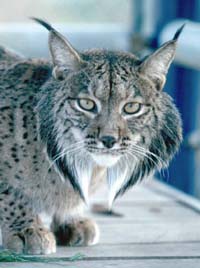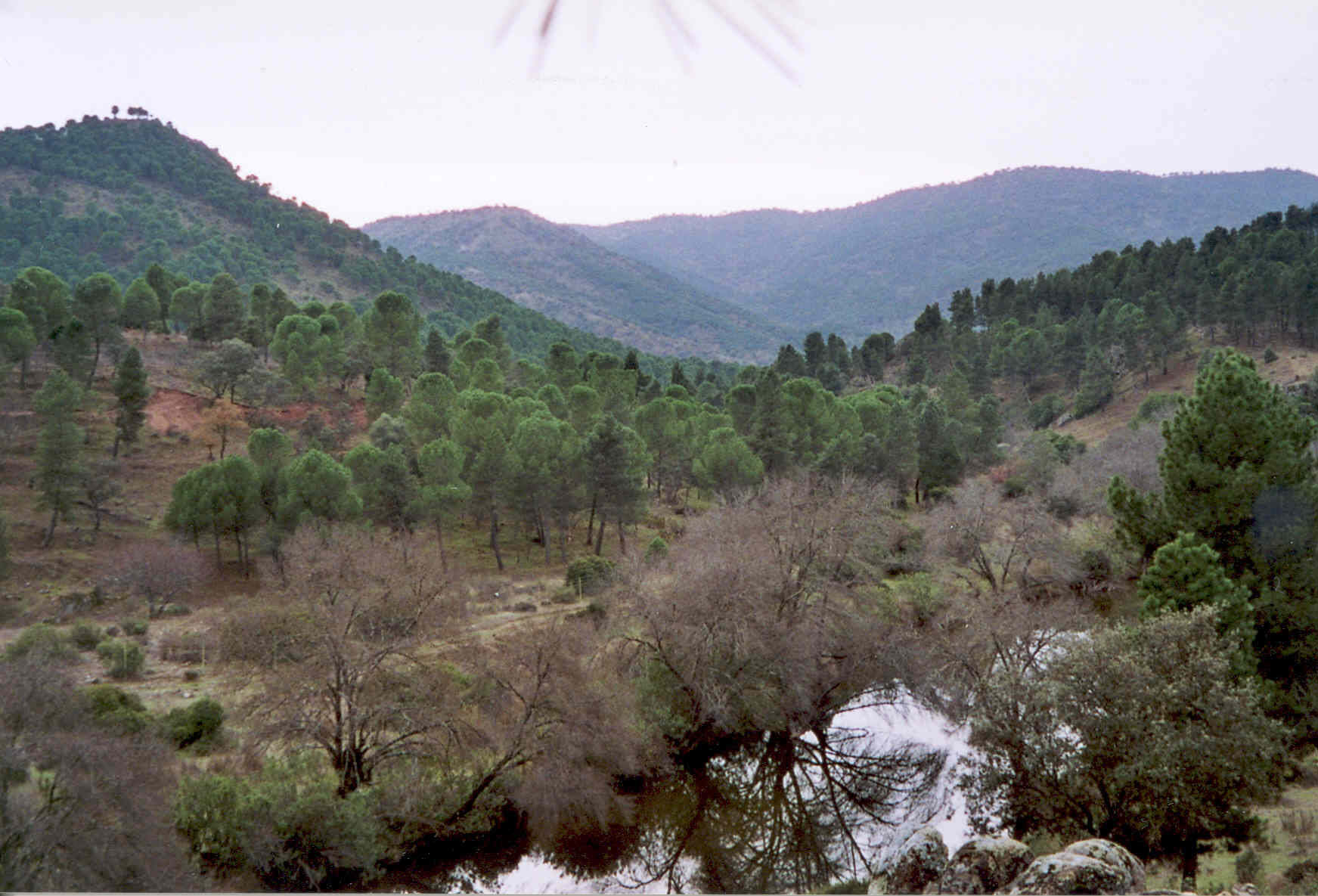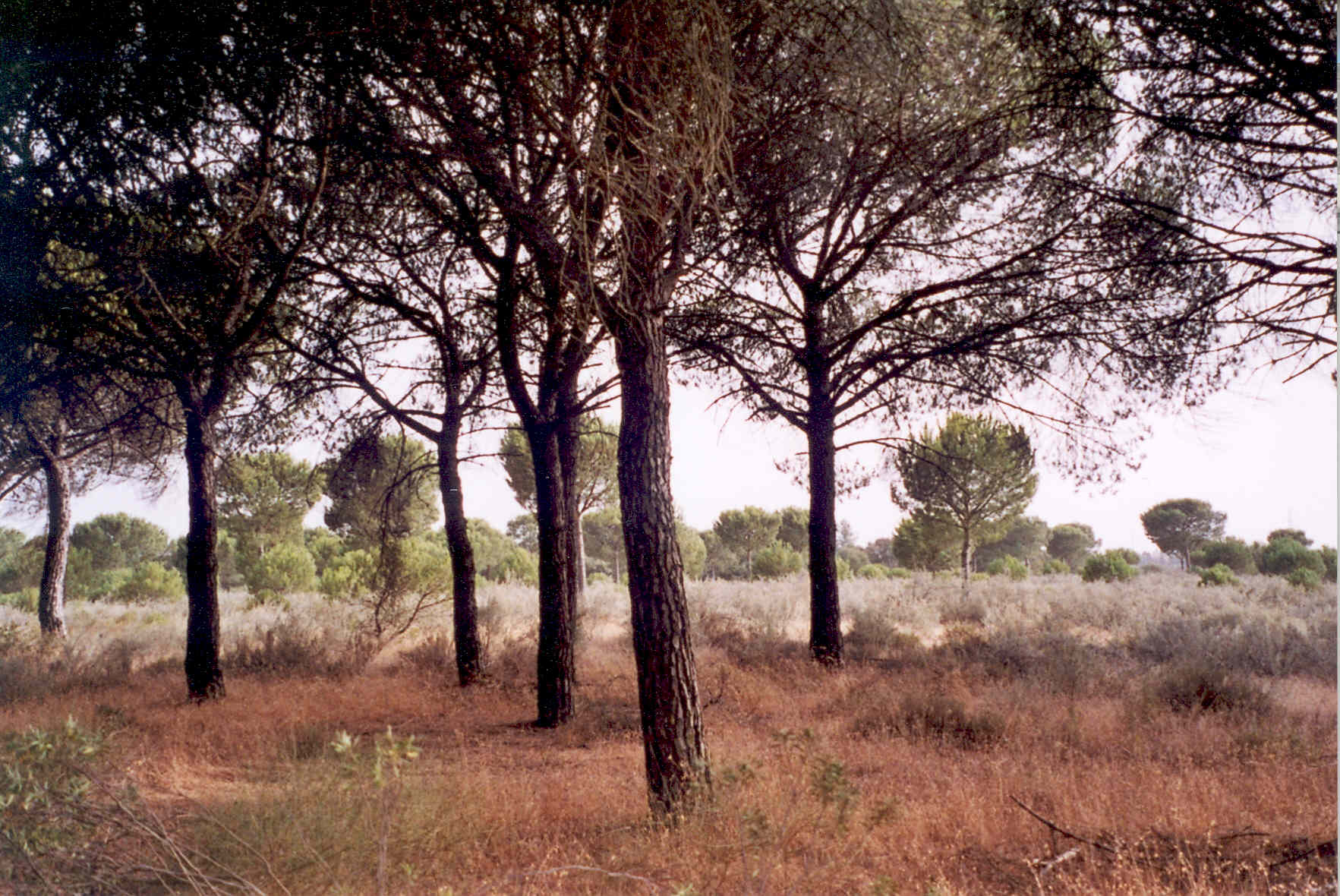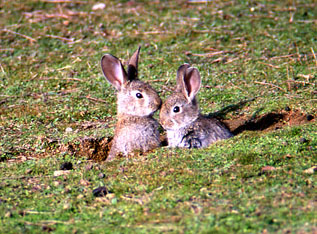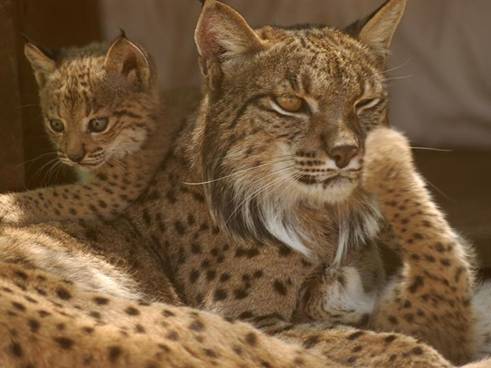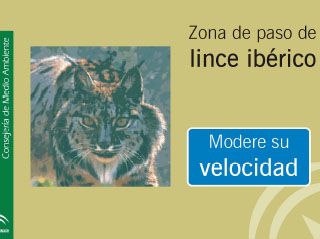|
|
|
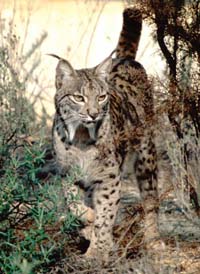 |
|
Source: |
|
Background: |
| back to top | |
|
Although lynx living in Iberia were first described as a distinct species as early as in the first quarter of the 19th century, a lasting controversy has taken place since some influential taxonomists regarded them just as the small-sized, southwestern subspecies of the Eurasian lynx. Besides, some of the authors that defended the Iberian lynx specific identity included under the same species most (or all) of the spotted lynx populations living in southeastern Europe and the Caucasus. During the second half of the 20th century accumulated paleontological and morphological evidence strongly suggested that the Iberian lynx and the Eurasian Lynx (Lynx lynx) were two different species. This hypothesis received support from molecular analyses, that established an earlier evolutive divergence between the Eurasian and the Iberian lynx than between the Eurasian and the Canada lynx (Lynx canadensis). In consequence, only recently the Iberian lynx taxonomic position as an independent species has been widely accepted. Similarly, until the early 1990s details on Iberian lynx distribution, numbers, and population trends were either very roughly estimated or entirely unknown. |
|
|
The Iberian lynx is a habitat
specialist. With the exception of the flat, coastal Doñana area, the species is
largely confined to broken terrain below 1300 m, preferably covered with a
mixture of Mediterranean scrubland and open grassland, where intensive land
uses of any kind is absent. The
outstanding components of the Mediterranean
scrubland and forest are holm oaks,
cork oaks and gall oak (Quercus spp.) among the trees, Phillyrea
spp., Arbutus unedo, Pistacia lentiscus, and Viburnum tinus among
the shrubs, and some Cistaceae, Erica spp., Rosmarinus spp., Rhamnus
spp., among the scrubs. Patches of wild olive trees (Olea europaea var.
Silvestris), wild pear trees (Pyrus silvestris), Juniperus spp.,
or other species can be found, whereas in elevated and moist localities patches
of Fraxinus spp. or even Alnus glutinosa are also frequent. At the population scale, surveys based on signs and radiotracking data showed that scrubland is clearly and positively selected by lynx. Such selection has been interpreted in terms of the need of shelter for bedding and breeding provided by the scrubland. Rabbits are often abundant in the scrubland, but they need small open areas (pastures, cereal fields and so on) interspersed within it. Lynx have disappeared from many areas covered with dense scrubland, mainly in the north but also in some southern places of the Iberian Peninsula. These extinctions are likely to be associated with low density (or absence) of rabbits. Thus, shrub protective cover alone is not enough to explain lynx preference for scrubland and the species optimal habitat could be defined as a patchy mixture of scrubland and openings where the interface length is maximized. In Doñana area, where some data on reproduction are gathered, hollow trees are used as breeding dens, but in other areas where this resource is very rare, other structures such as rock caves, boulder piles or ground dens can be used for the same purpose. A breeding female may use several auxiliary dens, and kittens are moved from one to another. Females can also hide their young offspring in very dense scrubland or already enlarged (e.g. by fox or badger) rabbit warrens. |
|||||||
|
|||||||
|
Although lynx can move at any time of day, activity peaks are in the
twilight, especially at sunset. Diurnal activity takes place mainly in winter. It
has been hinted that patterns of activity might follow those of rabbits. Adult
lynx live usually in stable home ranges that measure between 4 and 20 km2. In Doñana, the average female home range size is
12.6 km2 where rabbit density is
relatively low, and 5.3 km2 where
it is high. Values for males are 16.9 km2 and 10.3 km2,
respectively. The home range size of one adult female in Sierra Morena was 5.4
km2. As many other cat species, lynx maintain a solitary way of life. Males do not help to raise the kittens and, as a rule, they meet females only during the mating season. Adults defend their home ranges as territories against intruders of the same sex, especially in areas where rabbits are scarce. Male territories encompass one or more female territories. Females only breed when they hold a territory. Habitat quality, especially the rabbit abundance component, influences mean home range size, the social system and, as a result, lynx density. In the best known habitats of northern Doñana, lynx density is as high as 0.8 adults/km2, whereas in other parts of this area with only moderate rabbit densities, it ranges between 0.1 and 0.2 adults/km2. The estimated absolute density across most of the lynx range fluctuates around 0.08 adults/km2, a value one order of magnitude lower than the maximum density observed in Doñana. Most juvenile lynx definitively abandon the natal area when they are between 8 and 23 months old. Males disperse before and farther than females. Some females may inherit the maternal territory, or a part of it, or may settle down in a contiguous territory. Juvenile males use not to stay in or close the natal home range. Dispersal in the Doñana population lasts between a few weeks and 18 months. New territories are found by dispersing lynx at distances that range between 3 and 30 km from the maternal territory (mean 16 km). Dispersing individuals can use habitats of lower quality (less cover and less rabbits) than those where they come from and those where they settle down, rather as a result of avoiding areas occupied by resident lynx than a real avoidance of optimal habitats. During the dispersal process, lynx usually remain within habitats that offer natural cover, and rarely enter more than 2 km into open land. However, they proved able to cross tracts of uncovered habitats up to 5 km wide if there are one or more linear elements in the landscape (e.g. streams, hedges, roadside vegetation) that can be used as a guide to reach the edge of another suitable habitat patch at the other end. Mortality rates are very high during the dispersal phase. In the Doñana area only 12 out of 35 monitored animals survived and established themselves in a new home range. In Sierra Morena most lynx died during dispersal too. |
|||||||
|
|||||||
| Other vertebrates, including rodents, European hare (Lepus granatensis), red-legged partridge (Alectoris rufa), ducks, and geese (Anser anser) can be regularly killed and eaten in some areas and/or seasons, but they always contribute little to the lynx diet. Several ungulate species can occasionally be taken, especially in winter. Ungulate prey include juvenile red (Cervus elaphus) and fallow deer (Dama dama), and mouflon (Ovis musimon). Roe deer (Capreolus capreolus) has not been reported as a prey, perhaps just because it is absent in the areas where the lynx diet has been studied. | |||||||
|
|||||||
|
In the past, humans regarded the Iberian lynx either as a valuable
hunting trophy or as a vermin, put together with other predators in the bag of
competitors for small game. Reports of direct attacks to livestock (chiefly
goats and lambs) have always been scarce, and no attack has ever involved
people. In spite of the protected legal status of the species since 1973 (Spain) and 1974 (Portugal), levels of illegal persecution have presumably decreased very slowly during the last 25 years. Nowadays, it seems that lynx are rarely shot by poachers, mainly because of its own scarcity, and because at the same time they are no longer perceived as an important source of damages to the game business. Nevertheless, in many estates where small game is a significant source of income several non-selective predator control methods (snares, traps, poisoning), said to be targeted at other carnivore species, are sometimes allowed and legally (often illegally) used. As a result, lynx and other protected species are systematically killed too. Although the landowners general attitude toward the species as a predator might be close to neutrality, it tends to be negative when viewing lynx as a protected species. In protected areas even small restrictions applied to some land uses, and exceptionally to property rights, are never welcomed, and usually magnified as serious economic losses, by landowners. Since lynx conservation is sometimes one of the implicit reasons for reserve establishment, some owners blame lynx for their decreased profit. On the other hand, the same argument indicates the species potential as an appealing symbol for the conservation of the best preserved Mediterranean ecosystems, especially among urban people. The beauty and critical status of the Iberian lynx are favourable features to enhance social pride in taking care of the species and its habitat. |
|
|
Among the threats and limiting factors that affect lynx populations, it
may be useful to distinguish deterministic factors, which have caused, and
still do, a strong numerical decrease, from stochastic factors, whose effects
are especially amplified (through extinction vortices) in small populations. It
is important to be aware that most small lynx populations have been put under
the serious risks of stochasticity as a consequence of the former enduring
action of deterministic factors.
|
|||||
| a) Deterministic factors | |||||
| Habitat alteration | |||||
| The Iberian Peninsula
has been inhabited by shepherds and farmers for at least eight thousand years.
Assuming that grassland openings were not very common within pristine forests,
early settlers could have indirectly favoured lynx by firing and cutting the
original Mediterranean forest, and by ploughing the resultant open ground,
because these transformed habitats might have sustained denser rabbit
populations. It must be emphasised that such perturbations improved lynx
habitat only when enough forest was left in the landscape. Moreover, habitat
improvement is probably better when several small open patches are interspersed
within the forest matrix than when a single tract of habitat of the same size
is altered. This is the reason why traditional agricultural practices in the
mountains (e.g. small clearings to obtain firewood or charcoal, small orchards,
extensive livestocking) have benefited lynx, and why the features of modern
intensive agriculture (e.g. large developments for irrigation systems, lower
diversification of agricultural landscapes as constrained by mechanisation) are
detrimental for the species. At the opposite extreme, the increase
in scrub density following the abandonment of farming practices lowers habitat
suitability for rabbits and lynx. Large average size of estates is an outstanding feature of land property in southern Spain. That is, a large area is owned by a few people. This may lower diversity in management styles. At present, hunting is the main source of income in these areas. During the last decades, economic profitability has caused deep changes in hunting management, namely a higher concern for big game to the detriment of small game, and a switch from extensive to intensive practices in big game. Rabbit populations dwindle steadily under these conditions. Moreover, dense scrubland is also extremely beneficial to wild boar (Sus scrofa) and other efficient predators of rabbit litters. Varied edge effects arise from human leisure activities in lynx areas. Urbanisation (both legal and illegal) is still growing and threatening some of the best lynx populations. The vicinity of human dwellings has been found to be strongly avoided by Iberian lynx. There are some cases of new housing projects in the heart of critical areas for the lynx as, for instance, near Andújar (Jaén Province, Spain). There are already altered landscapes that are not suitable for lynx reproduction but allow lynx dispersal. Further modifications in these habitats may hinder lynx movements, increase the mortality of dispersing individuals, and reduce or prevent emigration between populations. The rapid development of transport infrastructures (e.g. roads, railways, channels) favours human access to wild areas, reduces the permeability of the landscape to lynx movements, and increases lynx mortality (e.g. traffic casualties). |
|||||
| Habitat removal | |||||
|
Whereas openings in a
matrix of forest can support more lynx than a dense, homogeneous forest,
clearance progression through centuries has often ended in an inverted landscape,
with a few forest patches within an agricultural matrix. Lynx can not live in
this kind of landscape, even when some rabbits are retained. In the Iberian
Peninsula extensive extirpation of woody plants for farming went on clearly
until the 1960s, when human emigration from rural to urban areas became a
social wave, and scrubland clearance started to level off. Today, this trend
might have reversed, as the European Union produces a surplus of agricultural
products, and policies tend to promote farming abandonment and afforestation
programs. There are, however, exceptions linked to intensive, economically
profitable crops. For instance, in the surroundings of the Doñana National
Park, the scant patches of scrubland left continue to be removed for growing
vegetables under plastic shelter. |
|||||
| Prey scarcity | |||||
|
In the Iberian Peninsula rabbit
populations have experienced a pronounced decline during the last forty years.
Unfortunately there are very few records of this striking decrease but, for
instance, in the Doñana National Park current rabbit numbers are estimated to
be less than 5% of the species population levels in the 1950s. Rabbits are now
relatively scarce everywhere, and in marginal range, where climate or soil
conditions are not optimal, they have disappeared. The rabbit collapse has been
ultimately attributed to two main causes: changes in land use and disease. It
is believed that these factors originally weakened rabbit populations, making
them more vulnerable to several proximate factors including elevated hunting
pressure and high predation levels by generalist species. |
|||||
|
|||||
| Human-induced mortality | |||||
|
Available information indicates that
a significant amount of lynx are killed directly by humans. Fully intentional
illegal hunting still occurs, but its importance as a relative source of
mortality is difficult to assess because these events are largely kept confidential.
In Spain, the proportion of reports that involved illegal hunting during the
1980’s was 26%. In Doñana, at least 5 lynx have been shot during the last 15
years. The annual mortality rate due to this cause has been estimated as 5%
from the radio-tracked sample (n=63 lynx for >30,000 days). All the
carcasses embodied gun pellets commonly used in small game hunting. Lynx are
sometimes killed by hunters waiting in hides for red deer on the large hunting
estates of the Iberian mountains. There are also reports of lynx caught by dogs
during big game hunting, although this kind of death is rather uncommon. In
Portugal, illegal shooting during legal game events or fox hunting, had been
identified as the most important cause of mortality of lynx. Traps have been, and still are, the main cause of direct human induced mortality in Spain, where trapping accounted for 44% of lynx deaths during the 1980’s. In the past, when rabbits were abundant, hundreds of traps worked daily for several weeks in each hunting estate for rabbit harvest. Many furbearers, including lynx, died in those traps, as selling fur complemented the income of professional trappers. After the rabbit crash this occupation has almost disappeared, but as lynx survive in the best rabbit areas, where it is still worthwhile to set traps, some individuals are caught now and then. The impact of traps set for controlling predators as a mortality factor is much higher at present. In Sierra Morena Mountains the annual mortality rate due to this cause is at least 25% , according to radio-tracking of 12 lynx (>3,500 days). In Doñana, illegal trapping and hunting with dogs amount of an annual mortality rate of 6%. Fox control is allowed for short periods across the lynx range, but authorized methods, the duration of the trapping term, and the allowed number of traps are violated almost systematically. Non-selective methods are forbidden, but used everywhere. Selective methods (i.e. cages) are often used in non-selective ways (e.g. cages are seldom visited or predators, including protected species, are shot). Actual administrative control of these practices virtually does not exist, and established sanctions for confirmed violations are not efficient enough to prevent them. So far systematic trap inspection on hunting estates has rarely been done. |
|||||
|
|||||
| b) Stochastic factors | |||||
| Demographic viability | |||||
| Some lynx populations [this is currently true for the Doñana population] are comprised of less than 10 breeding females. This small size makes them extremely vulnerable to extinction just by random variation in individual birth and death frequencies. For instance, the probability that in a given year only half the adult females produce litters and that all juvenile that survive the first year are males, followed by high female mortality in the following year, is very low in a large population but has reasonable chances to happen in several Iberian lynx populations. Events of this kind strongly affect population structure and survival chances in the short term. In accordance with such possibilities, most small populations present in 1960 went extinct within 30 years. | |||||
| Genetic viability | |||||
| Theory states that genetic variability is lost quickly in small populations. For instance, in the small Doñana population, two pelt morphotypes have disappeared in the last 50 years. Some alleles that are still present in Sierra Morena populations have not been found in Doñana lynx. There is no clear evidence of inbreeding depression, but some data suggest low sperm quality in males living in the Doñana area. | |||||
| Disease and catastrophes | |||||
| The reduced genetic variability of small populations makes them more exposed to diseases. Disease has been identified as a relevant mortality factor in other wild populations of felidae, including the feral cat and the lion, and only occasionally in some species of Lynx, but not in the Iberian lynx. Diseases diagnosed in wild or captive specimens of other Lynx species are feline panleucopenia, distemper, feline leukemia, chlamydiasis, and toxoplasmosis, among others. Forest fires, flooding, extensive pollution, or new disease outbreaks in rabbits, may completely wipe out a small lynx population within a very short period of time. | |||||
| Obstacles to conservation | |||||
| Political, administrative, social, and economic reality imposes many obstacles to the implementation of efficient lynx conservation strategies. The following difficulties are most relevant: | |||||
|
Lack of coordination between administrations |
|||||
|
Management programs of
[formerly] frontier lynx populations and habitats in different countries or regions have
seldom been coordinated. [There has been some improvement, however cooperation on the national as well as regional level could still be much better]. |
|||||
| Lack of incentives for the conservation of the lynx habitat | |||||
| Several socioeconomic factors lead to the destruction of lynx habitat. Private agents seem to perceive higher profitability in the use of Mediterranean forest for recreation and big game hunting than in the traditional multiple land use linked to patchy optimal lynx habitats. Further elimination of lynx habitat is supported by public administrations through forestry programs and various forms of agricultural subsidies. On the other hand, economic or social incentives to preserve optimal habitats for rabbits and lynx do not exist. | |||||
|
Human attitudes toward small game predators and their control |
|||||
| Despite dominant trends
leading to lynx habitat loss, large areas suitable for the species are still
available in Spain. The major land use in these areas is red-legged partridge
hunting, the management of which also favours rabbit populations. Lynx went
extinct on most of these hunting estates a long time ago as a result of
persistent, intensive predator control. Successful recolonization from existing
lynx populations seems very unlikely because of several factors that often
operate jointly. The distance between suitable areas without lynx and areas
with lynx are sometimes beyond the species’ dispersal ability. In other cases,
shorter distances cannot be crossed because of unsuitable dispersal habitat.
Source populations may be so weakened that dispersal rates are very low.
Finally, a critical reason is that predator control goes on in most small game
hunting estates. Hunters and gamekeepers concerned with small game consider red fox and other generalistic predators to be extremely harmful to their business, and predator control suppression is out of the question. Efficient methods for predator control are non-selective and, regrettably, alternative selective methods that are able to compete in efficiency have not been developed yet. Taking into account the general trends in land use, this particular methodological problem has crucial implications for lynx conservation. |
|||||
|
Limited knowledge |
|||||
|
Important decisions relevant to conservation necessarily rely on limited information about lynx biology, ecology, and behaviour. These aspects are barely known outside the Doñana area. |
|||||
|
The Iberian lynx is legally protected by the following laws and conventions:
|
|
| Source: Sánchez, I. & Vargas, A. 2005. Status of the Iberian lynx. EAZA News 50: 28-29. | ||||
|
Despite the various recommendations to initiate a captive breeding programme for the Iberian lynx, it was difficult to reach an administrative agreement that would push this initiative forward. In 1999, the Ministry of the Environment organised a workshop that was helpful in developing the Iberian Lynx Captive Breeding Action Plan. This plan was approved in February 2001 by the National Commission for Nature Conservation in Spain. Presently, the various actions included in the Action Plan are being carried out by the Iberian Lynx Captive Breeding Committee, a multidisciplinary group of professionals with several ad hoc advisors. The committee has four Advisory Groups: husbandry, genetics, health issues, and reproduction/ biological resources bank. Each group has a representative that coordinates the group’s tasks and reports progress to the committee.
Finally, in the summer of 2003, a MoA signed by the Ministry of Environment and the Andalusian Government gave an important impetus to the captive breeding programme. Under this MoA, both administrations selected the director for the Iberian Lynx Ex situ Conservation Programme, whose responsibilities include coordination of a national captive breeding programme and management of the El Acebuche captive breeding facility in Doñana’s National Park. Following the agreement, the Andalusian government agreed to capture new founders for the breeding programme, and in December 2003 ‘Garfio’, an adult male captured in Sierra Morena, was obtained. Garfio was placed with Esperanza during the 2004 breeding season, but was not acclimated yet to the captive environment, and the pair did not mate. Throughout autumn of 2004, four new cubs were captured for the captive breeding programme: three females from Sierra Morena and a male from Doñana. Presently, the captive breeding pool constitutes 13 (5.8) Iberian lynxes, of which ten are in El Acebuche and three at Jerez Zoo. Last January, four of the adult females at El Acebuche entered oestrous and copulated with three of the males. |
||||
|
||||
